Satyen Mohapatra
New Delhi, February 21, 2007
Japan wants to encourage studies of Hindu gods and goddesses found in their country. Saraswati, Laxmi, Brahma, Ganesha among large number of other deities are still prayed to there though under a different names.
Saraswati's sketches (Benzaiten in Japanese) sanctify kitchens in rural areas of Japan even now, says Director International Academy of Indian Culture Lokesh Chadra.
Japanese understood her as sa-rasavati or the goddess of the kitchen, Rasavati is 'rasoi' in Hindi.
Talking to the Hindustan Times the Japanese Cultural Counsellor Shigeyuki Shimamori said, "We would like to encourage more studies by scholars on the Hindu deities found in Japan."
It is the Mantrayana sect of Buddhism emphasising mantras (chants) and rituals through which Hindu deities reached Japan, Dr Chandra said. The Japanese also perform "homa" known as "goma" to their deities even today, they get ghee flown from Australia, he added.
Sarasvati or Benzaiten in Japanese is one of the Seven Lucky deities (Shichi-fuku-jin) blessing every home. Couples who desire to have beautiful daughters pray to her . She is known as the patroness of writers, composers, musicians and painters.
Besies veena holding Saraswati's another popular form of Sarasvati found in Japan is eight armed Saraswati holding weapons in each. In the Rig Veda itself Sarasvati is termed as "Vritra-hantri" or slayer of demons, Dr Chandra said.
In Golden Light Sutra there is a hymn to Sarasvati "May Goddess Saraswati protect us in the field of war". Many Japanese Generals used to pray to her to defeat their enemies. Japanese classical theatre NOH has a drama dedicated to Saraswati" Dr Chandra says.
"German scholar Philipp Franz von Siebold has written that in 1832 there were 131 Shrines dedicated to Goddess Sarasvati and 100 to Lord Ganesha in Tokyo itself .
A 12th century temple to Ganesha in Asa kusa suburb of Tokyo is a National Treasure of Japan." Hindu Gods and Goddesses were introduced into Japan in 806 AD by Kobodaishi a Japanese saint who went to China and brought with him Manytrayana text, scrolls and images.
Ganesha is worshipped as god of love by many young boys and girls for achieving success in their courtship. The old worship him for success in business, Dr Chandra said.
Letters or 'bijaksharas' for twelve devas like Agni, Varuna, Indra, Chandra, Nairritri, Prithvi, Ishana, Brahma, Aditya ,Yama, Vaishravana, Vayu,were calligraphed by Master Chozen in Siddham script (called Shittam in Japanese) a seventh century form of modern Devanagari, he added.






















